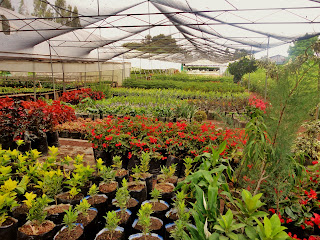Indeed I should have heeded Suzie's advice about Gravol on the road to Addis. Lesson learned.
As Suzie mentioned, we visited American/Dutch/Ethiopian managed Genesis Farms. The operation was unlike anything Suzie and I have seen our entire visit. Every aspect of the farm had been carefully managed to maximize efficiency. Seed germination greenhouses, watering schedules, and packaged dairy products at the farm's own grocer were just some of the features that the farm boasted. It was most impressive to see how a few simple steps could improve the quality and quantity of a farm's output. More about the farm can be found here: http://genesisethiopia.com/
On our last day of our trip we caught a ride from Bishooftu to Addis while Tilahun dropped off Dr. Debele (JUCAVM professor of Environmental Science) at a bus station. Unfortunately for us this meant a 4:45am wake up call, and driving around Addis for a couple hours waiting for a restaurant to open for breakfast. We couldn't help but wonder how on earth the bus system works here. From our perspective it seemed as though we drove to a parking lot full of buses (and lots of food vendors) while Dr. Debele hopped out to find a bus to Jimma. No signage, no clocks, no ticket booths. If we ever need to take a bus somewhere we're going to need much better Amharic!
As the city woke up we took a visit to some old relatives at the Ethiopian National Museum. On the upper floors we got to check out a wide variety of ancient Ethiopian artifacts: tools, dishes, thrones, paintings..you name it! But what we were really excited to see were the bones of the many hominids (relatives of humans, more so than chimps) that have been unearthed here in the last century. Most notably, a molded replica from the remains of 'Lucy' (Australopithecus afarensis), a partial skeleton discovered in the Awash Valley in the 70's. The remains are apparently over 3 million years old and represent an important step in humans' evolution. A wealth of information on Lucy can be found all over the web, but here's a good overview for those interested: http://news.nationalgeographic.com/news/2006/09/060920-lucy.html
We finished off the morning by touring around Addis with Tilahun. It's really quite a city. Development everywhere; condos, office buildings, industry. In parts of the city we noted a stark juxtaposition between the rich and poor, where mansions on a hillside overlooked a sea of slums. Many people here comment on the widening gap between the wealthy, middle class, and impoverished. The future of the capital's society and culture is surely at an important crossroads. Addis is a city to stay tuned to for sure!
That's all for now, we're back on JUCAVM campus until our journey to the North.
Ciao!
Manny
As Suzie mentioned, we visited American/Dutch/Ethiopian managed Genesis Farms. The operation was unlike anything Suzie and I have seen our entire visit. Every aspect of the farm had been carefully managed to maximize efficiency. Seed germination greenhouses, watering schedules, and packaged dairy products at the farm's own grocer were just some of the features that the farm boasted. It was most impressive to see how a few simple steps could improve the quality and quantity of a farm's output. More about the farm can be found here: http://genesisethiopia.com/
On our last day of our trip we caught a ride from Bishooftu to Addis while Tilahun dropped off Dr. Debele (JUCAVM professor of Environmental Science) at a bus station. Unfortunately for us this meant a 4:45am wake up call, and driving around Addis for a couple hours waiting for a restaurant to open for breakfast. We couldn't help but wonder how on earth the bus system works here. From our perspective it seemed as though we drove to a parking lot full of buses (and lots of food vendors) while Dr. Debele hopped out to find a bus to Jimma. No signage, no clocks, no ticket booths. If we ever need to take a bus somewhere we're going to need much better Amharic!
As the city woke up we took a visit to some old relatives at the Ethiopian National Museum. On the upper floors we got to check out a wide variety of ancient Ethiopian artifacts: tools, dishes, thrones, paintings..you name it! But what we were really excited to see were the bones of the many hominids (relatives of humans, more so than chimps) that have been unearthed here in the last century. Most notably, a molded replica from the remains of 'Lucy' (Australopithecus afarensis), a partial skeleton discovered in the Awash Valley in the 70's. The remains are apparently over 3 million years old and represent an important step in humans' evolution. A wealth of information on Lucy can be found all over the web, but here's a good overview for those interested: http://news.nationalgeographic.com/news/2006/09/060920-lucy.html
We finished off the morning by touring around Addis with Tilahun. It's really quite a city. Development everywhere; condos, office buildings, industry. In parts of the city we noted a stark juxtaposition between the rich and poor, where mansions on a hillside overlooked a sea of slums. Many people here comment on the widening gap between the wealthy, middle class, and impoverished. The future of the capital's society and culture is surely at an important crossroads. Addis is a city to stay tuned to for sure!
That's all for now, we're back on JUCAVM campus until our journey to the North.
Ciao!
Manny
Addis Ababa from Mount Entoto, 3km Above the Sea
Impressive Greenhouses at Genesis Farms
Great Aunt Lucy



No comments:
Post a Comment